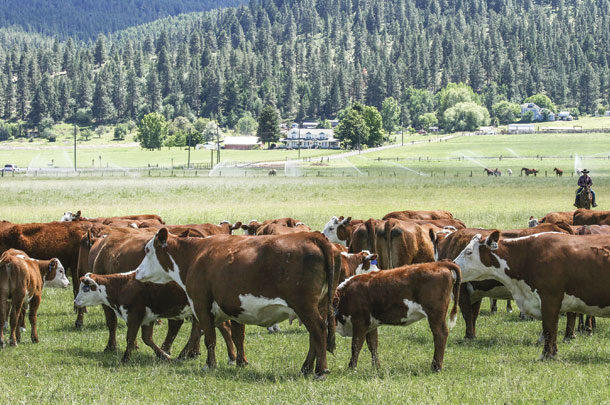In response, many breed associations have developed new ways of collecting unbiased data from producers and incentivizing them to participate. A prime example would be the whole-herd reporting programs.
Whole-herd reporting (WHR) is a system, either voluntary or mandatory, where participating breeders keep a log of inventory and data on all animals in the cow-calf herd each year. The information is then reported to the corresponding breed associations.
Types of data collected typically include things like information from birth to weaning, breeding details within the cow herd, reasons for death loss, culling decisions, abortions and so forth. The results are a calculation of unbiased reproductive genetic predictions which, in turn, create a much more accurate picture of herds and expected progeny differences (EPDs). The Beef Improvement Federation has been a supporter of WHR programs and advocates for producer participation.
Shared value for producers and breed associations
Formally reporting detailed information on the cow-calf herd takes time, effort and labor. Besides certain incentives, such as a cost break or price bundles on registrations and other services, there are tangible benefits to participating producers as well as the breed associations.
“Reproductive- and longevity-related traits are immensely important to the profitability of a cow-calf operation. Whole-herd reporting provides the data necessary to create better reproductive and longevity selection tools,” says Dr. Meagan Rolf, assistant professor at Kansas State University who specializes in genetics and genomics. “I would argue that more profitable cow-calf producers, and more live calves with improved reproduction, is also a benefit to breed associations and the larger beef industry because it increases member success and provides a greater supply of animals to the industry.”
Rolf also notes this kind of reporting provides information which is more useful because it produces more unbiased genetic predictions for growth traits. Therefore, it can account for better selection of post-weaning and reproductive traits.
She explains, “The big thing I can think of in terms of numbers is: Reporting data on all calves is actually to the producer’s benefit. If you think about the classic example of reporting only half of the calves in your calf crop, the intention being to report the best half generally, you essentially make half of your above-average calves look below-average and hurt yourself in the evaluation by not reporting everything.”
The Red Angus Association (RAA) first introduced the concept of this kind of reporting, known to the association as Total Herd Reporting (THR), in the early 1990s. In 1994, it received full endorsement when it was accepted by the membership at the National Convention in Polson, Montana, explained Melvin Leland, past RAA president, past RAA board member and a Red Angus breeder.
“Total Herd Reporting is a RAA mandatory registration program where every cow on the herd inventory must have progeny reported every year to maintain her registered status. Reactivation is possible but involves a significant fee,” said Leland. “The program is promoted to remove selective bias in herd data, to increase accuracy of breed data and eliminate the reporting of only a few select, favorite animals, which distorts the value of the information.”
Other associations have established and developed reporting programs of their own. The Angus Association has Maternal Plus, which they define as “a voluntary, whole-herd reporting system designed to capture additional reproductive trait data and, ultimately, expand reproductive and cow survivability tools.” Beefmasters Breeders United has their Whole Herd Reporting program. “With this system, BBU will be able to measure economically relevant beef production traits such as fertility, longevity and reproductive efficiency. Furthermore, the greater volume of data reported from each herd for measured growth and carcass traits enhances the accuracy of Beefmaster EPDs,” the association states.
The American Hereford Association has Whole Herd Total Performance Reporting (TPR), in place since 2001.
“The AHA implemented Whole Herd TPR because of the importance of members reporting complete calf crops and not just the best animals in a herd,” said Shane Bedwell, COO and director of breed improvement. “Breeders have a tendency to not want to report animals that are substandard in their herds because they feel they aren’t important as they don’t plan to use or market them as breeding animals, or they don’t want it known how those animals perform.
Breeders not reporting all of the data will cause the genetic evaluation to provide results that don’t accurately reflect the animals in their herd. AHA gives members all the tools they need to report complete information based on how they are most comfortable reporting the information.” AHA has both paper forms and an electronic system for the convenience of their members. This particular program is required to receive EPDs on registered Hereford animals.
Whole-herd reporting is a call to action for members to not only critically evaluate their own herds but also be part of present and future improvement of fellow breeders.
“Breed associations can only create tools as good as the quality and amount of data provided by producers on the trait of interest, so if there is interest in the tool, there should be interest in WHR,” Rolf explains. “Like any genetic evaluation, single-animal contemporary groups (i.e., breeding a single female or weaning a single calf at a time because there is no variation in the contemporary group) aren’t useful in the evaluation, but everyone can benefit from reporting this data and will be more likely to get really good predictions for their animals, as their animals will be well represented in the data used to create the tool.”
Value to a larger cause
Besides the short-term value individuals can gain from participating in WHR programs, the data collected ultimately benefits the larger long-lasting cause of the entire beef industry, commercial and purebred. This kind of formalized data collection is the best way to generate good EPDs related to fertility and longevity. Good examples of this are traits such as stayability and heifer pregnancy rates.
“Fertility is one of the most important traits affecting profitability of the cow herd,” stated Bedwell. “Without whole-herd reporting, such a trait is very hard to get at. In December 2017, AHA launched one of the only fertility/longevity genetic evaluations in the U.S. We continue to look into the whole-herd reporting data on a continual basis to see what additional economically relevant traits we can generate for our members and participants of our whole-herd reporting program.”
Leland echoed similar sentiments. “All stakeholders, whether registered, commercial or purveyor, benefit from WHR as data is more complete,” he said. “The larger the population included in the statistical analysis, the more accurate it becomes.”
As the beef industry adopts new technology and advancements, data still must be contributed from the source – the producers in the field. Leland noted this will continue as the industry moves ahead, but it requires participation.
“As genetic advancement in beef cattle evolves, the accuracy of reported data becomes a benchmark for future evaluations,” he continued. “Genomic evaluations are valuable predictors, but all measurement needs to come from compared analysis, and that needs to be accurately collected on the total herd population.” ![]()
PHOTO: Various cattle breed associations strongly encourage or require their membership to contribute to whole-herd reporting programs. The resulting information is then used to provide information to breeders and the industry as a tool for mating and management decisions. Photo by Paul Marchant.
Jaclyn Krymowski is a freelancer based in Ohio.












